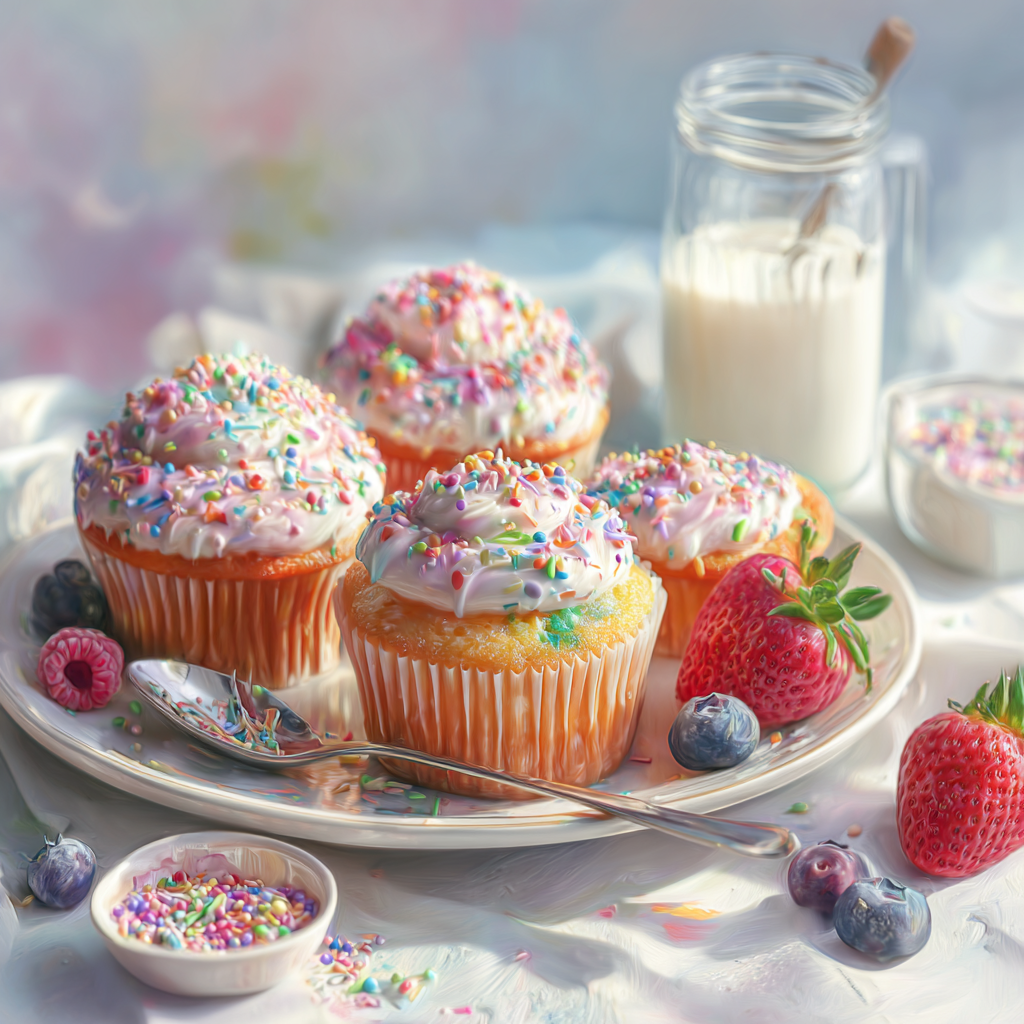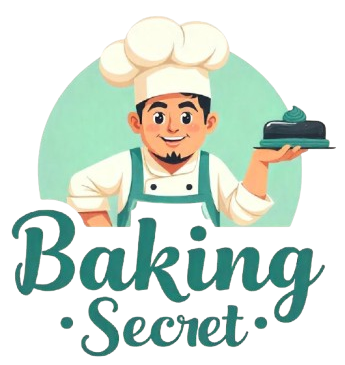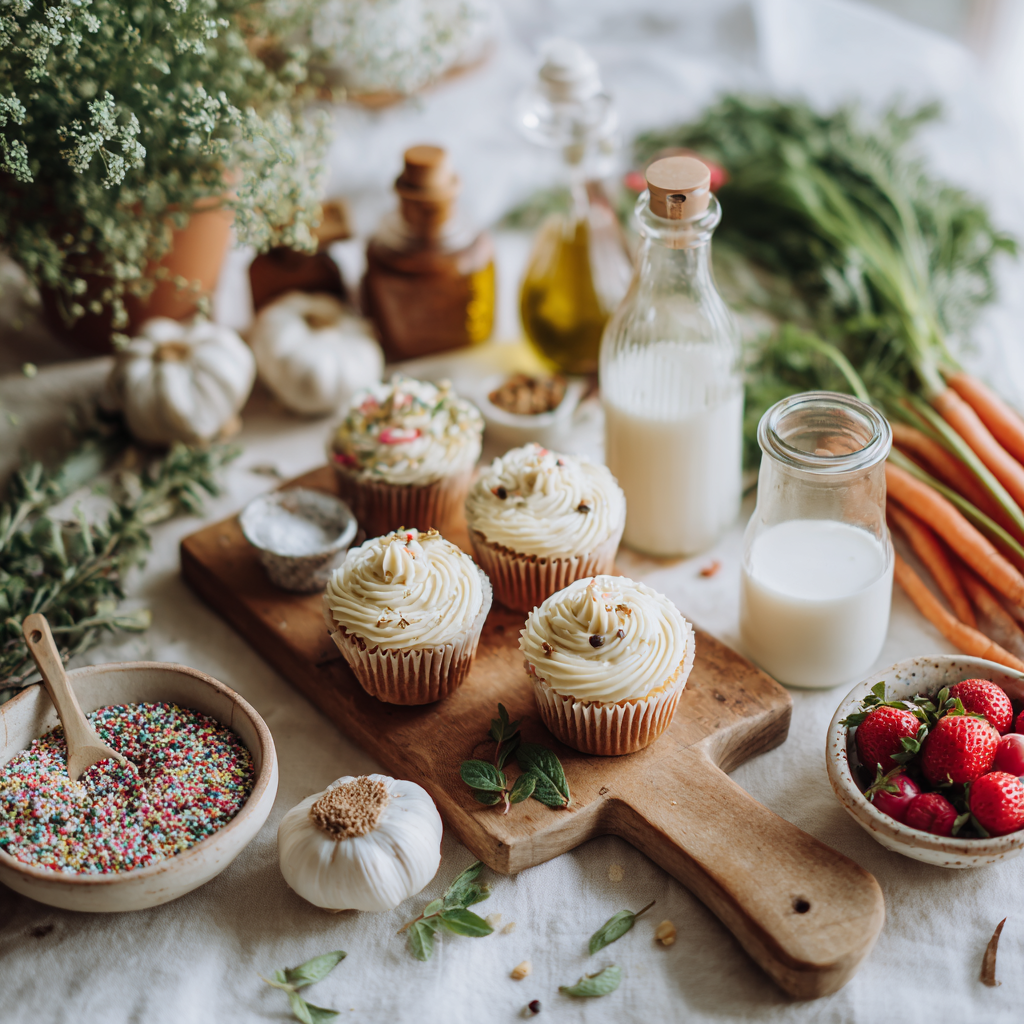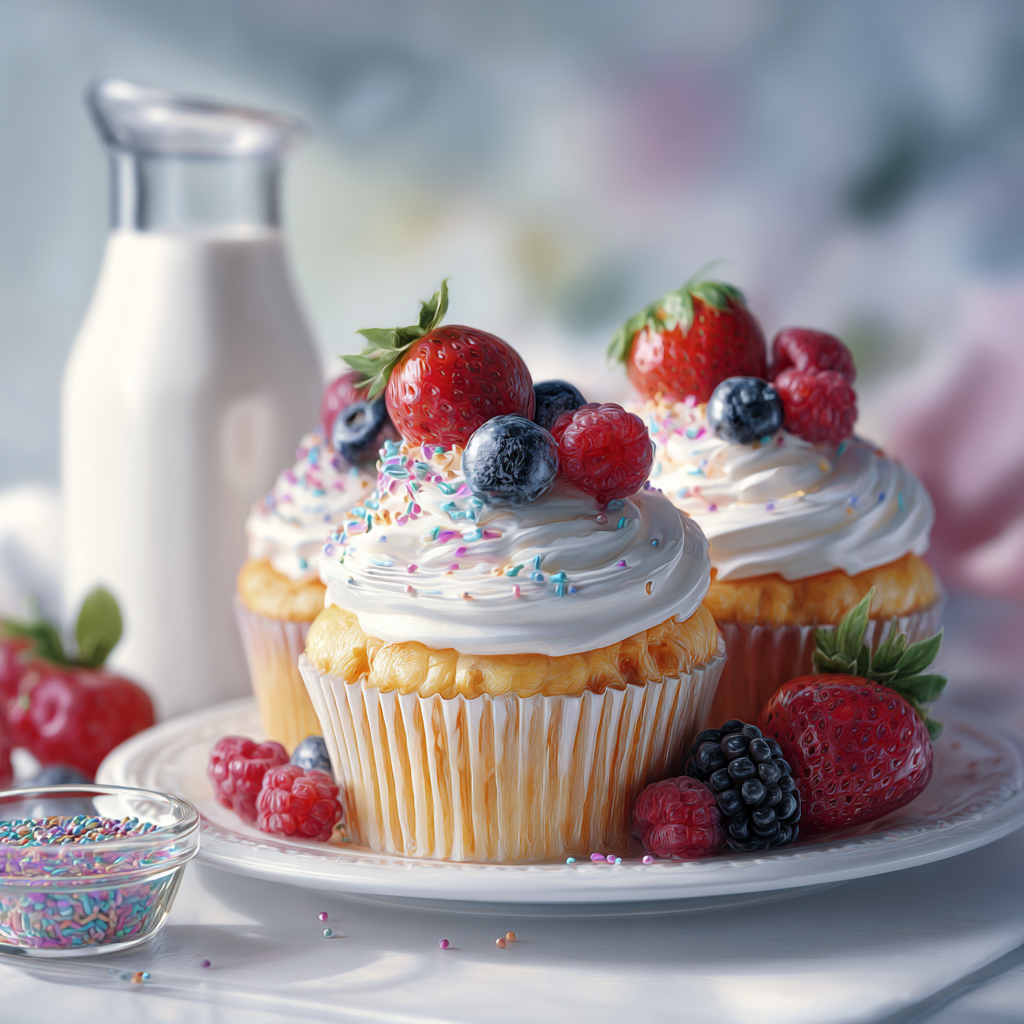Introduction
I still remember the first time I baked a batch of cupcakes. The smell of vanilla filled the kitchen, and my family gathered around, eager to taste my creation. But what happens when someone can’t enjoy them because of dietary restrictions? That’s when I discovered my passion for making treats everyone can savor, no matter their diet. Over the years, I’ve learned that baking dairy-free doesn’t mean giving up flavor. In fact, it opens up a world of creativity in the kitchen.
Dairy-free diets are more popular than ever. Whether it’s due to health needs, ethical choices, or simply personal preference, many people are cutting out dairy. But here’s the good news: you don’t have to give up your favorite desserts. With cupcake recipes dairy free, you can whip up mouthwatering treats perfect for any occasion. Birthdays, holidays, or just a casual weekend—these cupcakes will leave everyone asking for seconds.
What makes these recipes so special? They’re not just about skipping dairy. They’re about proving that dairy-free desserts can be just as indulgent, rich, and satisfying as traditional ones. Plus, they’re versatile. Whether you’re baking for someone with allergies or simply want to try something new, these cupcakes will quickly become a staple in your recipe collection.
Why Go Dairy-Free?
Why do people choose dairy-free diets? For starters, lactose intolerance affects millions worldwide. Others avoid dairy due to allergies or sensitivities. Some people make the switch for ethical reasons, like supporting animal welfare or reducing their environmental impact. No matter the reason, one thing is clear: going dairy-free doesn’t mean missing out on delicious food.
Vegan cupcakes and other dairy-free desserts prove that flavor isn’t lost when you ditch the butter and milk. Coconut oil, almond milk, and plant-based alternatives bring their own unique richness to recipes. These ingredients help create cupcakes that are moist, fluffy, and full of taste. Trust me, even the biggest skeptics won’t notice the difference.
What Does Dairy-Free Mean?
So, what exactly does “dairy-free” mean? Simply put, it means avoiding all products that come from milk. This includes butter, cream, cheese, yogurt, and whey. Some people think dairy-free just means swapping cow’s milk for almond or soy milk, but it goes deeper than that. Reading labels carefully is key to keeping things truly dairy-free.
Don’t worry—going dairy-free doesn’t mean your desserts will lack flavor. In fact, it often leads to discovering new ingredients and techniques. For example, using mashed bananas or applesauce can add moisture without needing eggs or butter. And coconut cream makes frosting extra creamy. Once you start experimenting, you’ll see how easy it is to bake amazing cupcake recipes dairy free.
If you’re new to this, start small. Swap one ingredient at a time and see how it changes the texture or taste. Before long, you’ll feel confident creating treats that everyone loves. Remember, baking is about sharing joy, and these recipes let you do just that, no matter who’s at the table.
Essential Ingredients for Dairy-Free Cupcakes
You know, baking without dairy used to feel like trying to solve a puzzle with half the pieces missing. But once I figured out the right swaps, it became one of my favorite challenges. The key is knowing what to replace and how to do it without sacrificing flavor or texture. Trust me, your cupcakes will still have that melt-in-your-mouth magic.
Let’s talk butter first. Butter gives traditional cupcakes their rich flavor, but guess what? You don’t need it. Coconut oil is my go-to substitute—it adds moisture and a subtle tropical hint that works wonders in recipes. If you’re not a fan of coconut, try olive oil or even vegan margarine. They blend seamlessly into batters and keep things light and fluffy.
Milk is another biggie. Almond milk is probably the most popular choice, but oat milk has been stealing the spotlight lately. It’s creamy and slightly sweet, which makes it perfect for desserts. If you’re feeling adventurous, give cashew milk or soy milk a shot—both are fantastic non-dairy substitutes. By the way, did you know some plant-based milks come fortified with extra nutrients? That’s a bonus!
Now, eggs can be tricky, but they’re not impossible to replace. Flax eggs (a mix of ground flaxseed and water) are a game-changer. Let them sit for a few minutes, and voilà—you’ve got a gel-like binder that works just as well as an egg. Applesauce or mashed bananas also do the trick if you’re aiming for something a little sweeter. Funny enough, I once forgot to add any egg substitute at all, and the cupcakes turned out surprisingly decent. Not ideal, though—don’t skip it entirely!
Here’s the thing: these swaps aren’t just about making cupcakes dairy-free. They open up a whole new world of flavors and textures. For example, using coconut cream instead of heavy cream in frosting creates this luxurious, almost velvety finish. And speaking of frosting, have you ever tried making pumpkin cheesecake cupcakes? The combination of pumpkin spice and dairy-free cream cheese frosting is unreal.
Can I use store-bought frosting if I’m dairy-free?
Absolutely! Store-bought frosting can save time, especially when life gets hectic. However, you’ll need to read those labels carefully. Some brands sneak in hidden dairy ingredients like casein or whey. Look for frostings labeled “vegan” or “dairy-free.” Brands like So Delicious and Miss Jones offer amazing options that taste great and are completely safe for dairy-free diets.
If you’re unsure, scan the ingredient list twice—or three times, just to be safe. Honestly, I’ve learned the hard way that assumptions can lead to disappointment. Once, I grabbed a tub thinking it was dairy-free, only to find out later it had butter in it. Lesson learned: always double-check!
Step-by-Step Guide to Perfect Dairy-Free Cupcakes
Alright, let’s dive into the nitty-gritty of actually making these cupcakes. Don’t worry—it’s easier than you think. With a solid plan and the right ingredients, you’ll have a batch of easy dairy-free cupcake recipe perfection ready in no time.
First, gather your dry ingredients. Flour, sugar, baking powder, and a pinch of salt form the base of most cupcake recipes. If you’re going gluten-free too, almond flour or a gluten-free blend works beautifully. I love experimenting with different flours; each one brings its own personality to the mix. For instance, oat flour lends a hearty texture, while rice flour keeps things delicate.
Next, move on to the wet ingredients. Combine your chosen milk alternative with your oil or melted vegan butter. Add a splash of vanilla extract—it’s the secret weapon that ties everything together. Whisk until smooth, then slowly incorporate the dry mixture. Be careful not to overmix; lumps are okay here. Overmixing can make your cupcakes dense, and nobody wants that.
Pour the batter into lined cupcake tins, filling each one about two-thirds full. Pop them in the oven at 350°F (175°C). Baking times vary depending on your recipe, but 18–22 minutes is usually spot-on. While they bake, whip up some frosting. A simple buttercream made with vegan butter and powdered sugar pairs perfectly with almost any flavor. Or, if you’re feeling fancy, try the frosting from this recipe for Boston cream cupcakes. It’s divine.
Once the cupcakes are done, let them cool completely before frosting. Cooling is crucial because warm cupcakes can melt the frosting, leaving you with a gooey mess. Patience pays off here—I promise.
How do I know when my cupcakes are done?
This is where the toothpick test comes in handy. Stick a toothpick into the center of a cupcake. If it comes out clean or with just a few crumbs clinging to it, they’re ready. Another clue? The edges should look golden brown, and the tops will spring back when lightly touched. Don’t rely solely on time; ovens can be unpredictable.
Oh, and here’s a pro tip: rotate your pan halfway through baking. This ensures even cooking, especially if your oven has hot spots. Trust me, uneven cupcakes are frustrating, and rotating the pan solves that problem every time.
Speaking of frustration, have you ever tackled a giant cupcake cake? It sounds intimidating, but it’s surprisingly fun. Check out this giant cupcake cake recipe if you’re looking for a show-stopping dessert idea. It’s perfect for birthdays or special occasions.
Incorporating seasonal flavors is another way to elevate your creations. Fall is prime time for pumpkin spice, and winter calls for peppermint or gingerbread. Spring and summer beg for fruity twists like lemon or strawberry. Try adding a dollop of dairy-free whipped cream to these Cheesecake Factory red velvet cupcakes for a refreshing touch.
By the way, don’t stress if your first attempt isn’t flawless. Baking is part science, part art, and a lot of trial and error. My earliest dairy-free experiments were…well, let’s just say edible but not Instagram-worthy. Keep tweaking, keep tasting, and soon you’ll nail it.
So there you have it—a straightforward guide to whipping up gluten-free and dairy-free cupcakes that everyone will rave about. Whether you’re baking for dietary needs or just want to try something new, these tips will set you up for success. Happy baking!
Creative Ways to Decorate Your Dairy-Free Cupcakes
Let’s be honest—presentation matters. You can bake the most delicious dairy-free cupcakes in the world, but a little flair goes a long way when it comes to impressing your guests. Decorating dairy-free cupcakes is not just about making them look pretty; it’s about expressing creativity and adding that personal touch. Plus, it’s fun! Here are some ideas to spark your imagination.
Festive themes are always a hit. For birthdays, go all out with colorful sprinkles and edible glitter. I once made a unicorn-themed batch using pastel-colored frosting and gold-dusted sugar stars—they disappeared in minutes. Holidays? Think outside the box. For Halloween, use black cocoa powder for a spooky chocolate frosting and top it with candy eyeballs. Christmas calls for red and green swirls, maybe even a dusting of powdered sugar to mimic snow. And let’s not forget Valentine’s Day—pink frosting with heart-shaped sprinkles never fails to charm.
What if you’re just baking for a casual gathering? Keep it simple but stylish. A dollop of whipped coconut cream with fresh berries on top looks elegant and tastes amazing. Or try piping a classic swirl with vegan buttercream and adding a single raspberry or a sprig of mint for a pop of color. Honestly, sometimes less is more.
Here’s the thing: toppings don’t have to be complicated to be impressive. Crushed cookies, toasted coconut flakes, chopped nuts (if no one has allergies), or even a drizzle of dairy-free chocolate ganache can elevate your cupcakes instantly. Funny enough, my favorite topping hack is crushed pretzels. They add a salty crunch that pairs beautifully with sweet frosting. Trust me, people will ask how you thought of it.
By the way, if you’re looking for more inspiration, check out this collection of cake and cupcake recipes. It’s packed with ideas for flavors, decorations, and techniques that’ll keep your creative juices flowing.
What’s the best way to store dairy-free cupcakes?
Now that you’ve decorated your masterpieces, you might be wondering how to keep them fresh. Storing dairy-free cupcakes properly ensures they stay moist and delicious for as long as possible. If your cupcakes are frosted with a sturdy frosting like vegan buttercream, they can sit at room temperature for up to two days. Just make sure they’re in an airtight container to prevent them from drying out.
If your frosting contains ingredients like coconut cream or fresh fruit, it’s safer to refrigerate them. Place them in the fridge, again in an airtight container, and let them come to room temperature before serving. Cold cupcakes can taste a bit flat, so giving them time to warm up makes a big difference. Pro tip: Write the date on the container so you don’t forget how long they’ve been sitting there!
For longer storage, freezing is your friend. Wrap each unfrosted cupcake individually in plastic wrap, then place them in a freezer-safe bag. They’ll last up to three months this way. When you’re ready to enjoy them, let them thaw overnight in the fridge, then frost and serve. Easy peasy.
FAQ Section
Got questions? Don’t worry—I’ve got answers. Here are some common queries about baking dairy-free cupcakes:
Can I make these ahead of time?
Absolutely! In fact, preparing cupcakes ahead of time can save you stress, especially for events. Bake them a day or two in advance and store them in an airtight container. Frost them the day of serving to keep everything looking fresh. If you’re really pressed for time, freeze the baked cupcakes and frost them later.
Are there nut-free dairy-free cupcake options?
Yes, there are plenty of nut-free alternatives. Coconut oil is a popular dairy-free fat, but you can swap it for olive oil or sunflower oil if nuts are a concern. For milk substitutes, opt for oat milk or soy milk instead of almond milk. Always double-check labels on packaged ingredients to ensure they’re nut-free.
Do dairy-free cupcakes taste different?
Not necessarily. With the right substitutions, most people won’t notice a difference. Ingredients like coconut oil and oat milk bring their own unique qualities, but they blend seamlessly into the recipe. Honestly, I’ve had friends swear my dairy-free cupcakes tasted “better” than traditional ones. Maybe it’s the extra love that goes into them.
Can I use gluten-free flour for dairy-free cupcakes?
Definitely! Gluten-free flours work well in most dairy-free recipes. Look for a 1:1 gluten-free flour blend to simplify things. Almond flour and oat flour are also great options if you’re experimenting. Just remember, gluten-free batters might behave slightly differently, so adjust accordingly.
How do I prevent my cupcakes from being dry?
Dry cupcakes happen, but they’re avoidable. Make sure you’re not overmixing the batter, as this can lead to tough results. Adding a bit of applesauce or mashed banana helps retain moisture. Also, don’t overbake them—keep an eye on the timer and use the toothpick test to check for doneness.
What’s the easiest frosting for beginners?
Vegan buttercream is super forgiving and easy to make. Simply beat vegan butter with powdered sugar and a splash of vanilla extract until smooth. If it’s too thick, add a teaspoon of plant-based milk. Too thin? Add more powdered sugar. It’s practically foolproof.
Can I use natural food coloring?
Yes, and it’s a fantastic choice! Beet juice gives a vibrant pink hue, while turmeric lends a sunny yellow tone. Spirulina powder creates beautiful greens, and cocoa powder deepens browns. Natural colors are healthier and often taste better than artificial ones.
What if I don’t have piping bags?
No problem! Use a zip-top bag instead. Fill it with frosting, snip off a tiny corner, and pipe away. Alternatively, spread frosting with a knife or offset spatula for a rustic look. Imperfections can add character, trust me.
Are dairy-free cupcakes healthier?
It depends on the recipe. Some swaps, like using whole-grain flour or reducing sugar, can make them healthier. However, many dairy-free desserts still contain plenty of sugar and fat. Balance is key—enjoy them as treats, not health food.
Where can I find dairy-free baking supplies?
Most grocery stores carry basics like almond milk and vegan butter. For specialty items, check out health food stores or online retailers. Brands like Earth Balance and Miyoko’s are widely available and perfect for dairy-free baking.
In conclusion, don’t be afraid to experiment with your dairy-free cupcakes. Whether you’re trying new flavors, testing out creative decorations, or tweaking recipes to suit dietary needs, the possibilities are endless. Baking is about sharing joy, and these cupcakes are a wonderful way to bring people together. So grab your apron, turn on some music, and get baking—you’ve got this!

Equipment
- Mixing Bowls
- Whisk
- Toothpick
- Cupcake Tin
- Wire Rack
Ingredients
- 1.5 cups all-purpose flour (or gluten-free flour)
- 1 cup granulated sugar
- 1 tsp baking powder
- 0.25 tsp salt
- 1 cup almond milk (or other non-dairy milk)
- 0.5 cup coconut oil (or other vegetable oil)
- 1 tsp vanilla extract
Instructions
- Preheat your oven to 350°F (175°C) and line a cupcake tin with liners.
- In a bowl, mix together the flour, sugar, baking powder, and salt.
- In another bowl, whisk together the almond milk, melted coconut oil, and vanilla extract until smooth.
- Combine the wet mixture with the dry ingredients, and mix until just combined; lumps are okay.
- Pour the batter into the prepared cupcake wells, filling each about two-thirds full.
- Bake in the preheated oven for 18-22 minutes or until a toothpick inserted comes out clean.
- Allow the cupcakes to cool completely on a wire rack before frosting.


